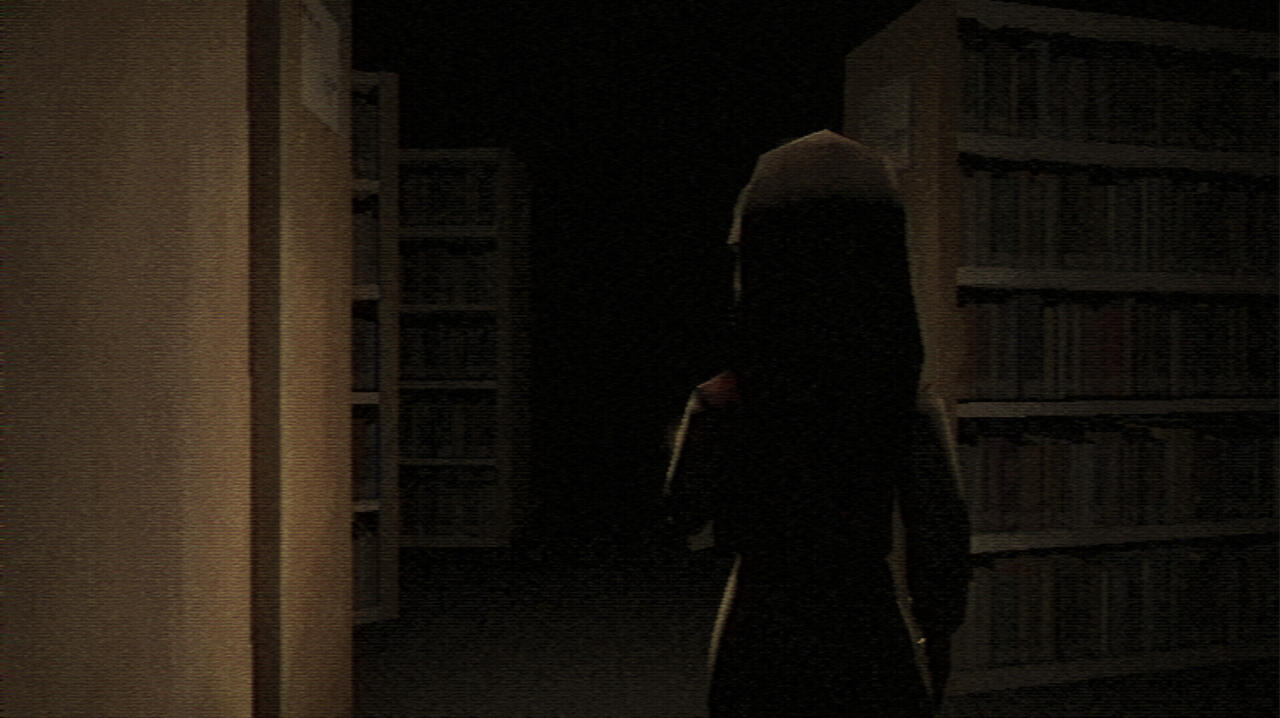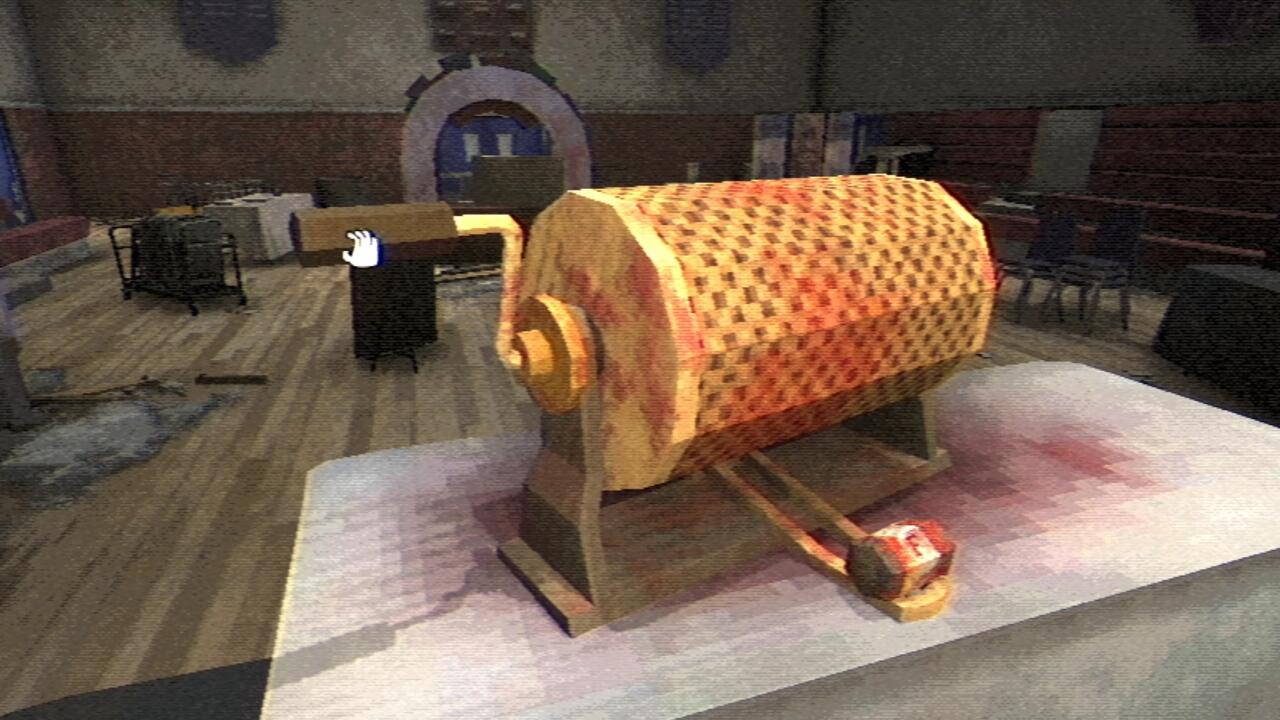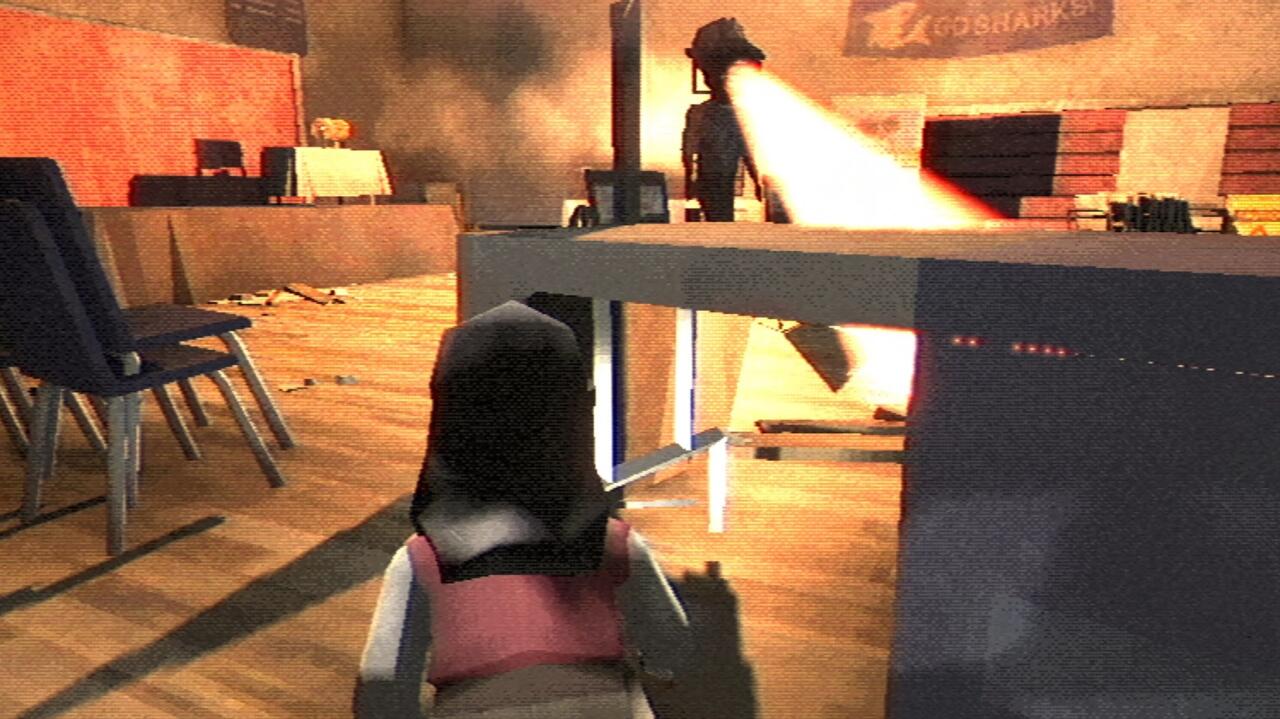Fear The Spotlight starts like many good horror stories. A couple of friends–nerdy goody-goody Vivian and her goth pal Amy–sneak into school after-hours to perform a séance. The school has a creepy history, after all, thanks to a fire a few years earlier that claimed the lives of several students. It’s a bit morbid and disrespectful to try to contact the spirits of a bunch of kids in the school library, but hey, teenagers are morbid and disrespectful.
I played a short demo of Fear The Spotlight at Summer Game Fest 2024’s Play Days event, and at first, that was the thing that stuck with me most–at least, at first. Sneaking through the halls of the school and listening to conversations between protagonist Vivian and Amy, the whole thing felt pretty natural and realistic. Goth kid befriends nerd and the pair get into trouble together–I’m sure a lot of people have that exact backstory in their lives somewhere.
Fear The Spotlight matches a 1990s teen horror story with a 1990s survival-horror aesthetic. The game calls up the look of early 3D games on the original PlayStation, most notably Silent Hill. The blocky, low-resolution visuals work well with the dark high school setting, giving the whole game a strange unreality that’s perfect for a ghost story.
The game, the product of the two-person, husband-and-wife team Cozy Game Pals, released in a previous form back in 2023. It has since been picked up for publishing by Blumhouse Games, the video game arm of movie production studio Blumhouse, and is re-releasing in Fall 2024 with additional story content. But despite having been around for nine or so months, Fear The Spotlight isn’t a game I had clocked before Summer Game Fest, and after trying it for a few minutes, I was disappointed I hadn’t heard of it before.

The demo started with Vivian and Amy making their way through the halls and heading toward the library. Along the way was a quick stealth segment, in which the girls ducked under a table to avoid the scanning eye of a surveillance camera. That would be the spotlight from the title, with staying in the shadows to avoid being seen being a major gameplay element.
When we get to the library, we see the other major gameplay element: first-person puzzle-solving. Vivian sets off to retrieve a spirit board (otherwise known as a Ouija board), which is kept in a glass display case in the library. To get it open, Vivian needs a key from the library’s office; to get into the office, she needs a keycard. Each time she interacts with one of those elements, the game cuts from a third-person perspective to first-person. You guide a cursor around a static version of the glass case to find the parts you can move or interact with. Touching the display’s lock, for example, brings up Vivian’s inventory to choose an item to use with it, like a key.
These interactive moments also give you opportunities to learn more about the world around you. Like in Resident Evil or Silent Hill, hitting the activation button on any of the other objects in the case brings up a little bit of text about them, giving some of Vivian’s internal monologue about whatever she’s seeing or reading. Some of these moments are pretty insightful, giving a better sense of Vivian and Amy’s relationship. Fear The Spotlight seems to sport a high degree of attention to detail in providing little tidbits that enhance your understanding of the story. For instance, when Vivian retrieves the keycard from the information desk, we discover just how big a nerd Vivian really is–it’s her own keycard, because she’s one of the library’s top student volunteers.

Vivian brings the spirit board to a table where Amy is waiting, where there’s another bit of first-person interactivity. When Amy passes you a book of matches, you pull a couple from your inventory and light the candles to start the séance. Placing your cursor over the planchette and holding a button down simulates the way you’d interact with the spirit board in real life, but as Amy starts to ask questions, it starts to move around the board erratically. A dark figure appears behind Amy and the candles go out, plunging the room into pitch darkness.
From here, Fear The Spotlight takes a drastic turn, even for such a short demo. I relight the candles slowly and painfully, dragging each one from the match box individually. When the light is finally restored, it reveals that Amy is gone. Vivian grabs a candle to light the way, and you can start to walk through the library in search of your lost friend.
Even in the darkness, it soon becomes clear that the library has changed. First, it’s the path back the way you came, with bookshelves turned over to block the way. Then, it starts to seem like the library itself has shifted to become larger and more winding. The space itself feels too big. This is another point when the old-school PlayStation graphics amplify the weirdness of Fear the Spotlight. Checking down one pathway or another, you often see–or think you see–a figure in the darkness. Other times, you’re definitely chasing Amy through the stacks, but she somehow disappears in the unnatural space. Although there are a lot of creepy things going on, according to the press materials shared for the game, the spooks you’ll get from Fear The Spotlight are atmospheric–no jump scares to worry about here, if those aren’t your thing.


As Vivian calls to Amy and continues the search, a distant area of red light appears and a silhouette within it, but as we get close it vanishes, and suddenly, fire spreads through the library.
At this point, Fear The Spotlight is off the rails. We hurry through the library fleeing the fire, but the room has fully twisted, bookshelves and tables giving way to different walls. Red curtains hang ahead, recalling the extradimensional Red Room of the TV show Twin Peaks. As Vivian flees, the wall ahead cracks open, tearing through the memorial plaque for the students killed in the fire, creating a pathway. Vivian flees into the crack and the camera hangs back, focusing on the students’ photos–the faces have shifted from smiling students to screaming demons.
It’s there that Fear The Spotlight’s demo ends, giving just enough of a sense of Fear The Spotlight to be really enticing. While it’s not sporting the kind of intensity the survival-horror games it’s channeling were known for, the uncanny feeling created by the game’s graphical style and art direction pair perfectly with the spooky story the characters find themselves in. The demo wasn’t quite enough to get a full handle on everything Fear The Spotlight has to offer, but it did leave me wanting to see more.
Fear The Spotlight is set for its re-release with an additional one to two hours of new content, according to its Steam page, in 2024. It’s coming to PC, PlayStation 4, PS5, Nintendo Switch, Xbox Series X|S, and Xbox 360.
Don’t miss the rest of GameSpot’s Summer Game Fest coverage.
- SEO Powered Content & PR Distribution. Get Amplified Today.
- PlatoData.Network Vertical Generative Ai. Empower Yourself. Access Here.
- PlatoAiStream. Web3 Intelligence. Knowledge Amplified. Access Here.
- PlatoESG. Carbon, CleanTech, Energy, Environment, Solar, Waste Management. Access Here.
- PlatoHealth. Biotech and Clinical Trials Intelligence. Access Here.
- Source: https://www.gamespot.com/articles/fear-the-spotlight-is-a-ps1-style-survival-horror-game-without-the-survival/1100-6524300/?ftag=CAD-01-10abi2f



